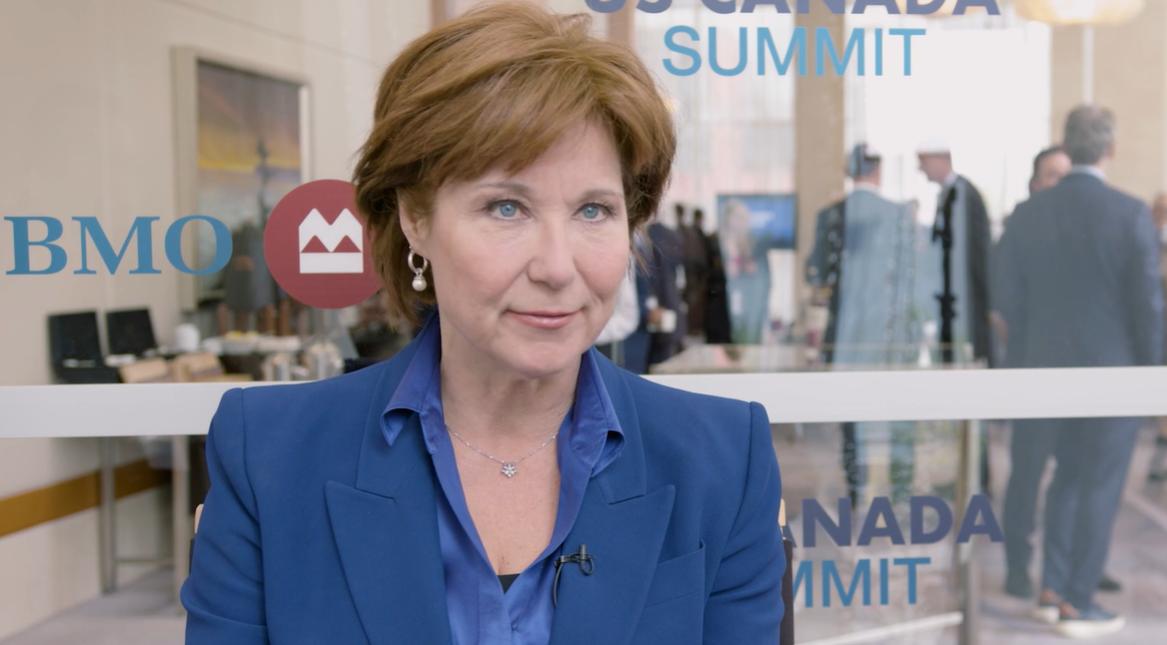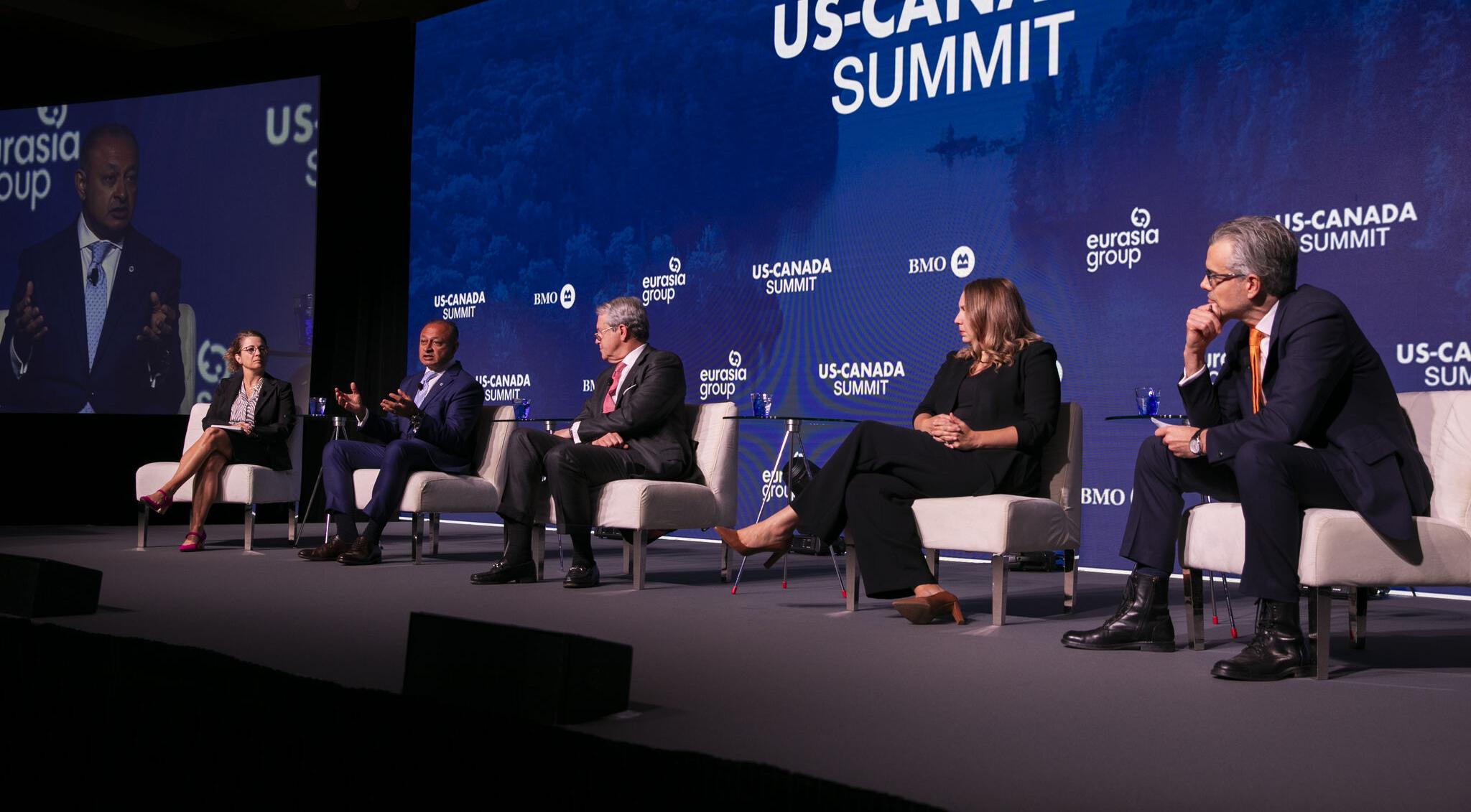
The Globe and Mail: For Canada and its U.S. trade relationship, complacency equals sleepwalking
-
bookmark
-
print

- Keywords:


This first published in The Globe and Mail![]() on June 5, 2024, authored by Darryl White, CEO of BMO Financial Group and Ian Bremmer, President and Founder of Eurasia Group and GZERO Media.
on June 5, 2024, authored by Darryl White, CEO of BMO Financial Group and Ian Bremmer, President and Founder of Eurasia Group and GZERO Media.
Trade negotiations – even between the closest of friends – are full of competing interests. For the United States and Canada, the fast-approaching review of the United States-Mexico-Canada Agreement (USMCA) will be crucial to maintaining a global leadership position and high quality of life for 380 million people amid increasing competition from current and emerging global powers.
While the 2026 review of the USMCA may seem far away, with a U.S. presidential election and a Canadian federal election in the meantime, complacency amounts to sleepwalking.
The rules governing trade between Canada and the United States drive economic growth because of the consumer value they deliver, and the predictability they provide businesses. These trade rules work because countries agree to live by them and settle their disputes through them. And as the American and Canadian experience with the last negotiation showed, when these rules are up for discussion it creates uncertainty for consumers and for the businesses they rely on.
Stakeholder politics become thorny, politicians are pressured to stand strong for the home front, and economic sectors fear becoming the sacred cow offered up in the name of national interest. And while the USMCA has just three signatories, the U.S.-China relationship looms large among nearly every bilateral and trilateral issue to be considered.
Six months out from the 2024 presidential election is an opportune moment to reflect on what is needed for the 2026 review of USMCA to deliver a winning outcome for Canada. This involves setting clear, mutually beneficial priorities, and creating the political conditions for success.
Let’s start with the priorities.
Since the bilateral trade pacts of the 1960s and the North American free-trade agreement that followed them, Canada-U.S. supply chains have benefited from the tariff-free treatment of most goods. This reduces trade frictions that hamper productivity while supporting private-sector-led growth needed to fight inflation, deliver savings for consumers and engineer North America’s economic advantage.
Trade among the three countries has now surpassed the US$1.5-trillion mark, with Canada-U.S. trade comprising more than half of that. The Brookings Institution assesses this regional bloc as accounting for almost one-third of global GDP.
The Canada-U.S. relationship – the world’s most successful bilateral relationship – creates the conditions to produce the goods that American and Canadian consumers want at competitive prices. It supports the system that underpins the U.S. dollar as the world’s reserve currency and helps to secure market access to export opportunities abroad for businesses in both countries. And it does it by complementing each country’s strengths, making the whole greater than the sum of its parts.
Canadian and American entrepreneurs and businesses have local access to the natural resources in greatest global demand, with recent examples of Ottawa and Washington teaming up to support junior Canadian critical minerals companies being the latest of enhancements to strategic supply chain security.
This continental integration is so deep that in sectors such as automotive manufacturing, goods can cross the border seven times during their production life. From factory floors and research laboratories throughout Canada, the U.S. and Mexico, vehicles are built in North America, by North American employees, primarily through North American supply chains, and bought by North American consumers. We should expand these continental relationships as electric vehicles become more widely deployed.
Priorities also need to take into account a modernization agenda. Updating the list of professionals covered by the trade agreement’s labour mobility rules will ensure companies can move their talent cross-border where it’s needed, when it’s needed – and inspire labour market integration at the sub-national level. If two more G7 countries (not to mention the entire European Union) can achieve productivity-boosting labour mobility, surely there’s hope for Canadian provinces to get it done.
But the political conditions must be in place to deliver on those priorities.
Delivering that support in the current economic climate has become more challenging with increased skepticism as to whether trade has delivered the widespread benefits – especially those experienced by consumers – promoted by the original NAFTA’s champions.
In the face of increasing geopolitical competition to North America’s advantage, business and political leaders have a responsibility to promote this partnership in the run-up to national elections. Soon-to-be-reviewed cross-border agreements are a good place to start.
This time there are no excuses. The U.S., Canada and Mexico must come to the table prepared to face strengthening global competitors with a clear set of mutually beneficial priorities, and the political conditions in place to deliver them.
Darryl is Chief Executive Officer of BMO, the eighth largest bank in North America by assets, serving over 13 million customers across Canada, the United States, an…(..)
View Full Profile >This first published in The Globe and Mail![]() on June 5, 2024, authored by Darryl White, CEO of BMO Financial Group and Ian Bremmer, President and Founder of Eurasia Group and GZERO Media.
on June 5, 2024, authored by Darryl White, CEO of BMO Financial Group and Ian Bremmer, President and Founder of Eurasia Group and GZERO Media.
Trade negotiations – even between the closest of friends – are full of competing interests. For the United States and Canada, the fast-approaching review of the United States-Mexico-Canada Agreement (USMCA) will be crucial to maintaining a global leadership position and high quality of life for 380 million people amid increasing competition from current and emerging global powers.
While the 2026 review of the USMCA may seem far away, with a U.S. presidential election and a Canadian federal election in the meantime, complacency amounts to sleepwalking.
The rules governing trade between Canada and the United States drive economic growth because of the consumer value they deliver, and the predictability they provide businesses. These trade rules work because countries agree to live by them and settle their disputes through them. And as the American and Canadian experience with the last negotiation showed, when these rules are up for discussion it creates uncertainty for consumers and for the businesses they rely on.
Stakeholder politics become thorny, politicians are pressured to stand strong for the home front, and economic sectors fear becoming the sacred cow offered up in the name of national interest. And while the USMCA has just three signatories, the U.S.-China relationship looms large among nearly every bilateral and trilateral issue to be considered.
Six months out from the 2024 presidential election is an opportune moment to reflect on what is needed for the 2026 review of USMCA to deliver a winning outcome for Canada. This involves setting clear, mutually beneficial priorities, and creating the political conditions for success.
Let’s start with the priorities.
Since the bilateral trade pacts of the 1960s and the North American free-trade agreement that followed them, Canada-U.S. supply chains have benefited from the tariff-free treatment of most goods. This reduces trade frictions that hamper productivity while supporting private-sector-led growth needed to fight inflation, deliver savings for consumers and engineer North America’s economic advantage.
Trade among the three countries has now surpassed the US$1.5-trillion mark, with Canada-U.S. trade comprising more than half of that. The Brookings Institution assesses this regional bloc as accounting for almost one-third of global GDP.
The Canada-U.S. relationship – the world’s most successful bilateral relationship – creates the conditions to produce the goods that American and Canadian consumers want at competitive prices. It supports the system that underpins the U.S. dollar as the world’s reserve currency and helps to secure market access to export opportunities abroad for businesses in both countries. And it does it by complementing each country’s strengths, making the whole greater than the sum of its parts.
Canadian and American entrepreneurs and businesses have local access to the natural resources in greatest global demand, with recent examples of Ottawa and Washington teaming up to support junior Canadian critical minerals companies being the latest of enhancements to strategic supply chain security.
This continental integration is so deep that in sectors such as automotive manufacturing, goods can cross the border seven times during their production life. From factory floors and research laboratories throughout Canada, the U.S. and Mexico, vehicles are built in North America, by North American employees, primarily through North American supply chains, and bought by North American consumers. We should expand these continental relationships as electric vehicles become more widely deployed.
Priorities also need to take into account a modernization agenda. Updating the list of professionals covered by the trade agreement’s labour mobility rules will ensure companies can move their talent cross-border where it’s needed, when it’s needed – and inspire labour market integration at the sub-national level. If two more G7 countries (not to mention the entire European Union) can achieve productivity-boosting labour mobility, surely there’s hope for Canadian provinces to get it done.
But the political conditions must be in place to deliver on those priorities.
Delivering that support in the current economic climate has become more challenging with increased skepticism as to whether trade has delivered the widespread benefits – especially those experienced by consumers – promoted by the original NAFTA’s champions.
In the face of increasing geopolitical competition to North America’s advantage, business and political leaders have a responsibility to promote this partnership in the run-up to national elections. Soon-to-be-reviewed cross-border agreements are a good place to start.
This time there are no excuses. The U.S., Canada and Mexico must come to the table prepared to face strengthening global competitors with a clear set of mutually beneficial priorities, and the political conditions in place to deliver them.
2024 US-Canada Summit
PART 1
Darryl White & Ian Bremmer on the Importance of the US-Canada Relationship
Darryl White | June 24, 2024 | Business Strategy, Doing Business In The U.S

Darryl White, CEO of BMO Financial Group, and Ian Bremmer, President and Founder of Eurasia Group and GZERO Media sat down to discuss the “Nort…
PART 2
Top Leaders Speak to the North American Advantage at the US-Canada Summit
June 24, 2024 | Business Strategy, Doing Business In The U.S

During the 2024 US-Canada Summit that we hosted with Eurasia Group, we sat down with top leaders to discuss the importance of the US-Canad…
PART 3
The US-Canada Partnership: North America’s Economic Outlook
Nadim Hirji | June 24, 2024 | Economic Insights, Doing Business In The U.S

The US-Canada economic relationship is responsible for millions of jobs and generates billions in trade. Against this backdrop, the USMC…
PART 4
How Private Equity is Adapting to Shifting Market Dynamics
Carrie Cook | June 24, 2024 | Business Strategy

Private equity investors are cautiously optimistic about North American markets after a tough past few years. Despite enduring a slew of macroeconomi…
PART 5
The Future of Work in North America: Reskilling and Upskilling
Mona Malone | June 24, 2024 | Business Strategy, Doing Business In The U.S

The nature, culture and meaning of work are undergoing a dynamic transformation: automation, digitization and the advent of generative artificial int…
PART 6
BMO Experts at the 2024 US-Canada Summit
June 24, 2024 | Business Strategy, Doing Business In The U.S

The 2024 US-Canada Summit featured senior decision makers from government, the private sector and society at large, and explored how to better unders…
PART 7
U.S.-Canada Summit Welcome Remarks
Darryl White | June 13, 2024 | Doing Business In The U.S

This is Year two of BMO’s partnership with the Eurasia Group, and I am pleased to welcome all of you here this morning to our U.S.–Canada…
Related Insights
Tell us three simple things to
customize your experience






Banking products are subject to approval and are provided in Canada by Bank of Montreal, a CDIC Member.
BMO Commercial Bank is a trade name used in Canada by Bank of Montreal, a CDIC member.
Please note important disclosures for content produced by BMO Capital Markets. BMO Capital Markets Regulatory | BMOCMC Fixed Income Commentary Disclosure | BMOCMC FICC Macro Strategy Commentary Disclosure | Research Disclosure Statements
BMO Capital Markets is a trade name used by BMO Financial Group for the wholesale banking businesses of Bank of Montreal, BMO Bank N.A. (member FDIC), Bank of Montreal Europe p.l.c., and Bank of Montreal (China) Co. Ltd, the institutional broker dealer business of BMO Capital Markets Corp. (Member FINRA and SIPC) and the agency broker dealer business of Clearpool Execution Services, LLC (Member FINRA and SIPC) in the U.S. , and the institutional broker dealer businesses of BMO Nesbitt Burns Inc. (Member Canadian Investment Regulatory Organization and Member Canadian Investor Protection Fund) in Canada and Asia, Bank of Montreal Europe p.l.c. (authorised and regulated by the Central Bank of Ireland) in Europe and BMO Capital Markets Limited (authorised and regulated by the Financial Conduct Authority) in the UK and Australia and carbon credit origination, sustainability advisory services and environmental solutions provided by Bank of Montreal, BMO Radicle Inc., and Carbon Farmers Australia Pty Ltd. (ACN 136 799 221 AFSL 430135) in Australia. "Nesbitt Burns" is a registered trademark of BMO Nesbitt Burns Inc, used under license. "BMO Capital Markets" is a trademark of Bank of Montreal, used under license. "BMO (M-Bar roundel symbol)" is a registered trademark of Bank of Montreal, used under license.
® Registered trademark of Bank of Montreal in the United States, Canada and elsewhere.
™ Trademark of Bank of Montreal in the United States and Canada.
The material contained in articles posted on this website is intended as a general market commentary. The opinions, estimates and projections, if any, contained in these articles are those of the authors and may differ from those of other BMO Commercial Bank employees and affiliates. BMO Commercial Bank endeavors to ensure that the contents have been compiled or derived from sources that it believes to be reliable and which it believes contain information and opinions which are accurate and complete. However, the authors and BMO Commercial Bank take no responsibility for any errors or omissions and do not guarantee their accuracy or completeness. These articles are for informational purposes only.
Bank of Montreal and its affiliates do not provide tax, legal or accounting advice. This material has been prepared for informational purposes only, and is not intended to provide, and should not be relied on for, tax, legal or accounting advice. You should consult your own tax, legal and accounting advisors before engaging in any transaction.
Third party web sites may have privacy and security policies different from BMO. Links to other web sites do not imply the endorsement or approval of such web sites. Please review the privacy and security policies of web sites reached through links from BMO web sites.
Please note important disclosures for content produced by BMO Capital Markets. BMO Capital Markets Regulatory | BMOCMC Fixed Income Commentary Disclosure | BMOCMC FICC Macro Strategy Commentary Disclosure | Research Disclosure Statements





